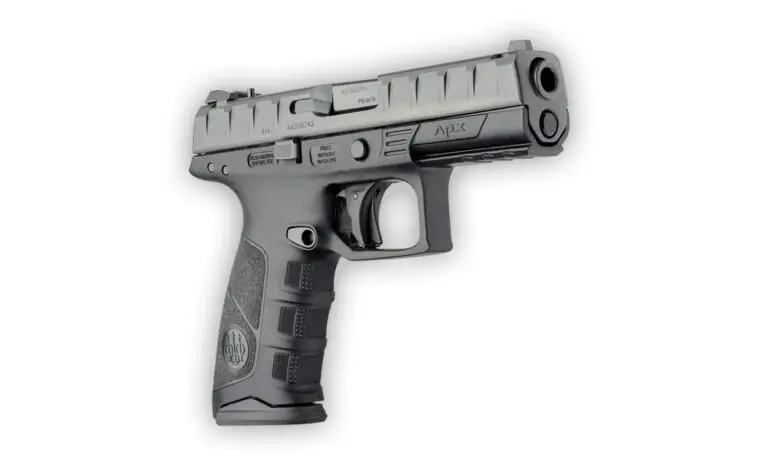On paper, the Beretta APX sounds like an awesome idea. It’s a striker-fired, double-stack pistol with a polymer frame. Furthermore, it comes with decent sights and, important for 2022, a rail to mount a laser built right in. Coming from one of the best-known and largest firearms manufacturers on the planet, this should be a competency entry into the polymer pistol market, right?
Well, according to the research we’ve been able to do on the APX, it has had its fair share of growing pains, and some of them are catastrophic enough that we’d be hesitant to recommend that you buy one.
In this piece, we’re going to cover four problems that the Beretta APX commonly has, and some of the solutions to those problems. Doing so, it’s important to note that to get this research, we’re relying on online accounts of events, as well as reviews. This is not a scientific study of the APX. For that, we’d kindly ask Beretta to send is ten APXs and 100,000 rounds of ammunition to use so we can test them out. The point is, take this, and everything else you read online, with a healthy dose of skepticism.
Ejector Failures
The ejector, a spring-loaded claw that grabs onto the rim of a cartridge after it’s been fired to extract it and make room for the next round, is a part that undergoes enormous and repeated stress. Thus, it’s recommended even in well-functioning firearms that you replace them from time to time to prevent dangerous failures. Some folks have reported that in their new APXs, the ejectors have shorn off and blown out of the gun, and sometimes into the shooter. This is highly dangerous, and will not only stop the gun from ejecting, it can also maim or kill the shooter. Always wear your eye protection, y’all.
Solution
Solving this, according to the sources we’ve read, meant sending either the broken ejector or the whole gun, back to Beretta. In either case, they’ve been relatively willing to repair the guns for free, or to send you the appropriate parts free of charge. This appears to be a defect in either metallurgy or manufacturing, and it’s a problem that the user is unlikely to solve themselves unless they have the time and skills to make their own ejectors out of better material, which is pretty unlikely.
Case Ruptures
Sometimes, when a round is fired, the case can rupture. In most guns, this comes from poor quality ammunition and is contained by the walls of the chamber. It means an annoying jam to clear, but it’s not dangerous. Apparently, the chamber design on the APX is a little bit on the short side, so that if the slide is very slightly out of battery when a case rupture occurs, it can send parts of that case (hot, sharp metal shrapnel) flying out of the receiver and into parts unknown. Obviously, this is extremely dangerous.
Solution
The most common fix we’ve heard to this one is to send the gun back to Beretta, and they send it back “fixed” with little explanation as to what was changed. We assumed that it is a matter of adding a stronger recoil spring to make sure that the gun is totally in battery for longer during firing, but we do not know. The source of the problem is likely in the geometry of the chamber, and we don’t think that can be fixed easily. A second version of the gun or aftermarket barrels are likely going to be the best solutions here.
Poor Accuracy
A duty pistol like the ATX ought to be able to place five rounds within about a three-inch group at ten yards for an average shooter. These are not competition pistols, and that’s okay. But some people are reporting averages of more than double that three-inch group at ten yards. There are several possible causes of this. First, it’s possible that some people simply do not shoot well with the APX’s sights. It could also be poor ammunition quality, or, though it’s extremely unlikely, poorly made barrels. Beretta doesn’t often make totally shoddy barrels.
Solution
The solution that a lot of people seem to be taking on this one is to add glowing paint to their sights or to have the sights replaced altogether with something that they like better. This solution might work well for you as well, but there are other things to consider that might also work. For example, try out different bullet types and loadings: you might find that your gun works better with some ammo over others. Also consider that it might be your trigger squeeze: dry fire training can be an excellent tool to remedy that particular issue.
Firing Pin Protrusion
According to a few posts we found, including pictures, the firing pin on the ATX can become stuck in a forward position, meaning that it will protrude from the slide further than it should. If it’s stuck in that position, it could cause an out of battery detonation, which would give you the aforementioned issue of case ruptures. In extreme cases, this could cause a catastrophic failure of the gun and injury to the shooter.
Solution
If this happens to you, stop firing the gun immediately, take pictures of the issue, and get in touch with Beretta. They should, ideally, send you a new slide and ask for the old one back for testing.
Conclusion
So far, it looks like the APX has some growing pains. This is usually a big problem in the polymer gun space since now Beretta has to compete with not only Glock, but Sig, both of whom are making polymer-framed handguns in the millions, and have a better track record for reliability. Overall, we wouldn’tt necessarily recommend that you purchase an APX with the aforementioned options out there, but we do hope that this design improves over time, especially in terms of safety.

Born in rural Texas, Logan has been a passionate gun enthusiast from a young age, influenced by his family’s deep-rooted tradition in hunting and sport shooting. He has carved out a niche as an authoritative voice in the firearms community, writing extensively about gun safety, hunting techniques, and the latest advancements in firearm technology.

